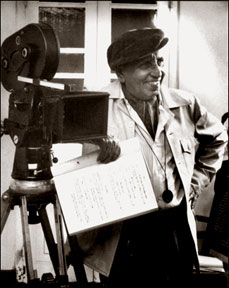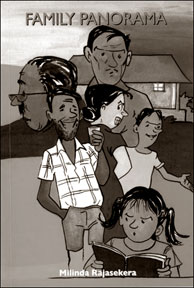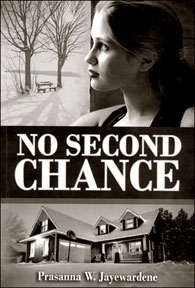
Moments in time
Not only frozen but reincarnated:
"Learn to see"
"A Photographic Essay" by L. E. Samararatne.
Published by Stamford Lake (Pvt) Ltd
By Lester James Peries
"All I want is to make you see"
David Wark Griffith - Legendary American Director
 Many, many years ago in my distant middle age a young photographer
came to take a portrait of me for a Sunday Newspaper. He seemed to know
precisely what he wanted. First he said I should wear that familiar Bush
- Jacket which I always wear on location. Many, many years ago in my distant middle age a young photographer
came to take a portrait of me for a Sunday Newspaper. He seemed to know
precisely what he wanted. First he said I should wear that familiar Bush
- Jacket which I always wear on location.
Then in case I was mistaken for a wildlife enthusiast, should I not
wear around my neck a cine - director's badge of his trade - the view-finder?Finally
he suggested I use the cap I wear rather rakishly, which in some bizarre
way was associated with me.
Now he said with professional expertise, I should stand by the
cine-camera - that would complete the picture.
That portrait has been my favourite in that particular period of my
life, smiling as though I had broken some box office record.
The photographer I need hardly add was L. E. Samararatne.
I was glad he sent me his book for a review, glad that I could pay
homage to a man whose passion for his chosen medium, the still camera,
never deserted him over the last 60 years of his working life.
|

Dr. Lester James Peries
Pic by L.E Samararatne |
Samararatne's life story reads like a Mark Twain fable. From the deep
south, a Rahula kid abandons his elementary education, arrives in the
Big City, works in Donald Studios in Maradana washing prints sticking it
out over the years, mastering the secrets of the dark room, graduating
to studio portraits, joining as senior assistant at Chitrafoto, the
fabled studio, inspired by D. R. Wijewardena, with Lionel Wendt's
collaboration and then to Lake house newspapers and the rest is history,
and part of the legend that is Samare."Learn to See". What is the real
purpose of this book? It is best explained by the author himself - let
me quote.
"My primary intention is to guide the artistically minded
photographer as to what the man behind the camera can achieve with even
the very basic equipment. "Learn to See" is a simple assertion and any
student with a love for taking photographs can find valuable insights
within the pages and perhaps these students who have a special fondness
for art will find it of greater interest and of invaluable worth".
Fair enough and clear enough I would say. Some photographs are
accompanied by copious technical details - such as exposures, lighting,
composition, lenses used, developing in the dark room, chemicals and
papers used etc.....etc.
On one level it is a "teaching text", an invaluable primer for both
the beginner and the advanced student.
But for the conscientious reviewer there is a problem. Samararatne's
book is much more than an educational treatise. It is also as the author
himself says a "photographic essay".
The essay opens out into an astonishing range of themes, subject
matter, treatment, in categories marked and sign-posted by the author
himself as follows - Pictorial, Women, Children, Men, News Travel,
Aerial art.
Samararatne has played many roles in his time, certainly more than
the seven that Shakespeare thought was everyman's heritage.
His news coverages of historic events in Sri Lanka's post
independence history should be part of the National Archive. The superb
aerial shots of the Colombo city are images which evoke an aching
nostalgia for a forgotten and distant past.
Having read the pictures carefully (I believe that is the fashionable
word) I would like to make two observations.
First, even on a casual glance through this extraordinary book of
photographs, the first thing that struck me was the power of the black
and white images. Black and White, though an abstraction of reality
appeared to create an almost tactile strength. It is this element in the
photographs that leaves a lasting impression.
Second, the best of Samararatne's photographs reveal the essential
difference between the still photograph and the moving image. Whether in
a documentary shot or the most artistically conceived picture, a moment
in time is not merely frozen, but time is redeemed, time is as it were
re-incarnated so that it not only provides instant pleasure but is that
significant moment caught and held for all eternity.
Witty and spirited dialogues
Family Panorama
Author: Milinda Rajasekera
A Sarvodaya Vishva Lekha Publication
by R. S. Karunaratne
 This is a collection of radio plays which brings out the goings-on in
an urban middle-class home of a family comprising six members: father,
mother, son, daughter, grandfather and uncle. This is a collection of radio plays which brings out the goings-on in
an urban middle-class home of a family comprising six members: father,
mother, son, daughter, grandfather and uncle.
The scenes portray the actions and reactions of the household facing
various problems, issues and events affecting them in their daily life.
In this portrayal the author brings out the virtues and vices, strengths
and weaknesses, prudence and stupidities of each character in the drama.
Apparently the author has attempted to drive some points home and
impart some lessons to society. The exchanges related under the title
"Free expression", for instance, give the reader some idea about the use
and abuse of the right to freedom of expression.
The scenes unfurled under "Decluttering" and "Place for everything"
impart some lessons on keeping homes spic and span.
The plays have both entertainment and educational value. The witty
and humorous dialogues are bound to keep the reader entertained. The
students of English will undoubtedly derive both profit and pleasure
from reading this book. Here are a few exchanges that embellish the
contents of the book: The following extract from, "Overhanding coconut
tree" shows the author's powers of imagination and use of language.
Percy: I'm blaming all women.
Emily: But you are not blaming Isabel.
Percy: Why not? Isabel is not a woman, you mean?
Emily: A woman? Fine woman she is... She's a vicious vixen, if you
ask me...
Percy (Laughing scornfully): Ho, ho, you're an angel! When did you
descend on earth, my guardian angel?
Emily: If I'm an angel, Percy, you wouldn't have had a chance of
marrying me... (Page 30) in "Ajith comes again" he depicts another
aspect of scriptwriting, attacking human foibles in a subtle way.
Ajith: Don't ask me why. I don't like her. I don't want to...
Menaka: All right then, It's immaterial whether you like her or not.
You don't have to like her.
Ajith: That means?
Menaka: That means both of you are acting. You are not required to
like her.
Ajith: No, no, I don't agree with you, Menaka. It's acting, no doubt,
but as Othello in the play, I've to show that I love Desdemona.
Menaka: Yes, you've only to show, only to pretend, you see.... (Page
68)
Taken us a whole the 21 radio plays that adorn the pages show the
author's powers as a creative writer. Apart from the witty dialogues,
students will derive immense benefit by reading them to improve their
English conversation.
Reconciliation
Torn between two worlds:
Author Prasanna W. Jayewardene
by Sajitha Prematunga
 'Snow' so near yet so far, something unattainable for most Sri
Lankans. This is sure to grab anybody's attention. This is the backdrop
of the book 'No second chance' by Prasanna W. Jayewardene, set in Sweden
this is a book about estrangement, regret, and nostalgia. 'Snow' so near yet so far, something unattainable for most Sri
Lankans. This is sure to grab anybody's attention. This is the backdrop
of the book 'No second chance' by Prasanna W. Jayewardene, set in Sweden
this is a book about estrangement, regret, and nostalgia.
Mostly a trip down memory lane this book is a segment of Ajith's
life. With growing senility and a deteriorating state of mind Ajith
keeps falling into a trance, reminiscing about the past.
He has a problem with sticking to one subject. As a result story
becomes a jumble of subject matter ranging from politics, war, theology,
wildlife, to procreation and sex. But the major theme is more than
hinted by the name. There is no second chance for those who let their
work engulf their lives.
A story about a workaholic who lost his family as a consequence;
Ajith is repeatedly harassed by unwanted recollections of the past. He
and his wife are separated, their daughter is separated from both -
their only mode of communication the telephone, which he claims they are
not very comfortable with, and he is completely estranged by his son,
whom we never come in to contact with.
His pain is clear through the narrative as well as through his own
comments e.g. he refers to his cottage in Sweden as a 'one time family
abode'. Until a Swedish reporter broke the ice and helped him to open
up. Consequently the book becomes a testimony of the yearning for a lost
way of life.
The gloomy setting of the story devoid of the tropical sun,
characteristic of Sri Lankan novels, is perfectly fitting for Ajith's
mood. It's an unorthodox setting for a Sri Lankan author.
A story told by a detached observer, there is little or no reference
to Sri Lanka, its culture, or even the protagonist's name at the
beginning - although this may have been intended to inculcate curiosity.
The narrator explains life in Sri Lanka as if he's explaining it to a
foreigner but explains Swedish culture, too in the same way.
Ajith is portrayed as an alienated soul torn between two worlds, who
seems to know more about foreign cultures than most Sri Lankans. Ajith
seems to draw strength from western culture.
The humbug attitude of Ajith towards Christmas does not necessarily
arise out of disrespect. On the contrary the respect with which the
narrator talks about Sansara and St. Lucia alike is amazing.
The book also provides a glimpse of how the other half lives for
those who are not familiar with it. But the writer is most successful in
securing the reader's sympathy for Ajith and thereby preventing the book
from becoming a confession of a spoilt rich kid.
Ajith is part philosopher and part political analyst. The narrative
together with the voice of the protagonist himself provides an insight
in to his opinions of complex political power plays. The protagonist's
contempt for Sri Lankan politics of the era in question is conveyed
without restrain. However the narrator's perspective appears, to me, as
largely one sided.
Often the narrative mingles with the voice of the protagonist making
it hard to discern who's talking.
The writer's discussions of most of his pet subjects in the book, may
suggest that the book contains a biographical note. Prasanna W.
Jayewardene's knowledge of botany, wildlife, automobiles are up-to-date
and is clearly presented through Ajith.
The book can also be considered as an attempt to reconcile the two
worlds - the east and the west, that Ajith is torn between.
Pre-historic links between Sri Lanka and India
by Nimal Dissanayake, Senkadagala Group
Correspondent
The book 'Pre-historic Mythological and Legendary links, Sri
Lanka-India' authored by Achal Kumar Malhotra was published recently by
B. R. Publishing Corporation, Delhi. It is scheduled to be launched in
Sri Lanka on Sunday, 16th September at 5.00 p.m. at Queens Hotel, Kandy.
The author Achal Kumar Malhotra was the Assistant High Commissioner
for India in Kandy from 2000-2004.
The book is about the uninterrupted interaction and continuous flow
of humans, ideas and influences between the two neighbouring countries
India and Sri Lanka.
Its material is based mostly on the Indian epic Ramayana and the Sri
Lankan chronicle the Mahavamsa.
The author has succeeded in portraying the pre-historic links between
the two countries. He has traced the origin of the Sri Lankan race to
the arrival of Vijaya. There is also a vivid description of the Veddahs
and Kuveni and the Indian connection with the introduction of Buddhism
to Sri Lanka from India, he establishes the intricate links between the
two neighbouring countries.
The book has four chapters, and runs into 128 pages, with coloured
photographs. However on the day of the launching the book will be sold
at a concessional price. The guest speaker at the launch will be
Professor Sudharshan Seneviratne, Department of Archaeology, University
of Peradeniya.
The event is organised by the Sri Lanka India Cultural Association (SLICA)
of the Central Province. |
